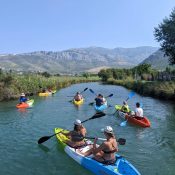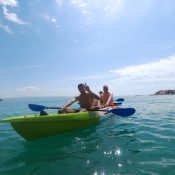A Short History of Standup Paddle Boarding & Where It Is Today

A Short History of Standup Paddle Boarding & Where It Is Today
A Short History of Standup Paddle Boarding & Where It Is Today
Modern standup paddle boarding originated in Hawaii from surfing in the 1900’s. In fact, for thousands of years Mankind has propelled themselves through the water on a board using a stick or pole as a paddle. There are records of these early forms of SUP being found across multiple contents as far back as 3,000 years ago. Natives in Africa would stand on their canoes and push themselves with their paddle. Warriors used it for stealth in battle. In the 1900’s in Tel Aviv lifeguards would use boards on the water and propel themselves over to people in need. Standup paddle boarding has been on the auxiliary of our senses for ages, without us even noticing it.
Emerging Old and New
When modern day standup paddle boarding emerged in Hawaii, characters such as Duke Kahanamoku and Dave Kalama emerged and helped bolster its appearance. By the 2000’s modern-day SUP moved from Hawaii to California, where it exploded in popularity. Professional athletes such as Chuck Patterson, Colin McPhillips, and Byron Kurt began to form professional SUP race teams. By 2005 SUP began to be recognized as a means to a variety of sports. SUP touring, yoga, and fishing took off in popularity as well, and a variety of boards began to be offered to the public for various uses. The world’s first official SUP event was held in 2007 in Lake Tahoe, California dubbed “Ta-hoe Nalu” (the event still runs today). And by 2012, the world saw its first Standup World Series Championship race in Oahu, Hawaii.
Standup Paddleboarding Today

standup paddle boarding in croatia
Today, SUP is enjoyed by all age groups, all over the world. SUP’s soaring popularity has led to a decrease in consumer prices for boards, as well as an increase in the available types of boards and materials used for construction. Paddles also have seen a revolution of their own, coming in various designs and materials. It’s popularity has also led to an increase in safety regulations and with good reason.

So next time you get out there and hit the waves, remember that standup paddle boarding has been used and enjoyed for thousands and thousands of years. Being out on the open water on your board is one of the most natural things you can do. What’s your favorite form of SUP?

Sup sunset in split
All Categories
Recent Posts
The Cold History of Kayaking: From Inuit to Today
7-Type of Flatwater Kayaks
How to use iSup





